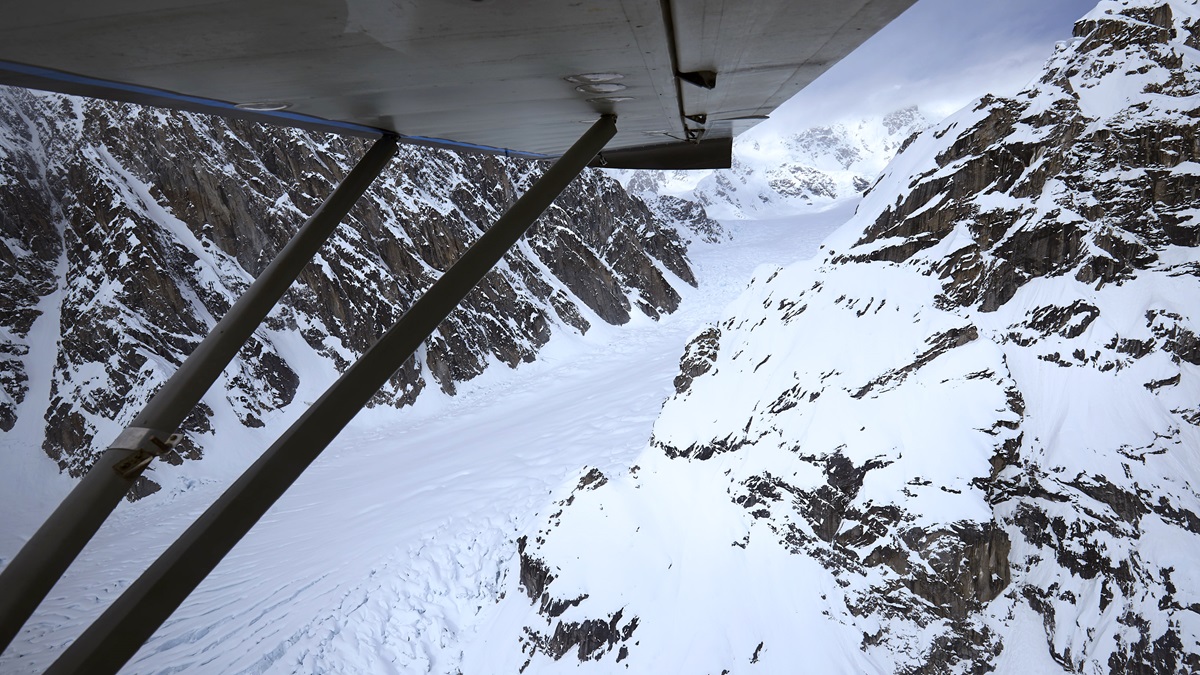See Denali National Park from above…and below
Eight tips to fly yourself around the Alaska Range
Sheer, snow-dotted cliffs of the Alaska Range in Denali National Park extend thousands of feet above and below my altitude in the tailwheel-converted Piper PA–22. This big-screen view could be right out of a blockbuster film, but I’m the lucky one living it instead of watching a Hollywood actor flying across a green screen.
Don Lee, the owner of Alaska Floats and Skis, an instructor, a designated pilot examiner, and an A&P/IA; AOPA Senior Photographer Mike Fizer; and I are climbing slow enough in the PA–22 that I can bask in the beauty of these natural wonders near Talkeetna, Alaska. Lee points to a pass, explaining that because more terrain beyond the pass comes into view as we approach we’ll be able to clear it. Passes that I’ve flown before in Alaska were at least a mile wide and extended to the ground. This one looks like a “U” carved out of the top of a narrow mountain.
Denali National Park is open for pilots to fly in themselves, but without extensive mountain flying experience, I recommend flying with a local who is familiar with the mountains and associated weather. I flew with Lee and talked to Talkeetna Air Taxi pilot and AOPA Opinion Leaders blogger Leighan Falley to gather eight tips to keep in mind if you plan to fly yourself in the Alaska Range or Denali National Park.
- Plan ahead. Study, plan, and prepare the aircraft and route of flight. Carefully preflight the aircraft and make sure it is equipped with survival gear, and study all available flight information. “You need to be taking a piece of meat out of the freezer before you leave, you are thinking so far ahead to dinner,” Lee says.
- Read the weather. Pay attention to the types of clouds at the tops of the mountains for details on the angle and strength of the wind. Clouds and fog (or lack thereof) will also signal where the air is calm and where it’s turbulent. “Even before you get into the mountains, you are already reading the wind,” Lee explains. Similarly, know the signs for rising and descending air in the mountains.
- Enter high, exit low. Gain altitude before you enter the mountainous areas. We start our climb in the PA–22 right after takeoff from Talkeetna Airport and spend the next 20 or so minutes climbing steadily toward the Alaska Range. We can’t outclimb the steeply rising terrain, so we plan ahead to be at a safe altitude to cross mountain passes. “It’s easy to get up inside of them and maybe not have enough altitude to get over the piece of terrain you originally thought you were going to be able to get over, especially if you don’t know the specific altitudes of the passes,” says Falley. We begin our descent as we follow the Ruth Glacier out of the park.
- Identify hazards. Lee quips, “20,000 feet is a whole other atmosphere” than where we are at 7,500 feet in the PA–22. Denali, the highest peak in the Alaska Range and on the North American continent, rises to 20,310 feet. Its peak isn’t a hazard to me, but what’s close to my altitude can present danger.
- Don’t get disoriented. The horizon isn’t visible when surrounded by close mountains. Lee encourages me to pick a point in front of the PA–22 and aim at it to fly level. “Everything is rising so radically, your natural tendency is to pull back,” Lee counsels.
- Have a plan of escape. Always have an exit strategy and know the way out in case poor weather or rapidly rising terrain necessitates a change of plans. Each cove we turn up is wide enough for us to turn around and exit toward lower terrain.
- Study the Alaska Supplement. Falley recommends reviewing the Alaska Supplement to learn the reporting points and associated frequencies: “On a sunny day, it can be a very congested place and there’s specific directions you have to fly through certain passes and one should be fully aware of this information before they fly their own airplane up there.” The FAA also publishes a Denali Flight Advisory with details.
- Watch for traffic. The views are absolutely stunning, but don’t forget to fly the aircraft and watch for other traffic. That’s something I had to remind myself constantly. “A midair collision is a definite threat up there,” Falley notes. “There’s a lot aircraft flying around up there, and that’s probably the biggest challenge.”
But the challenges, with proper training and planning, can pay off with big rewards.
Lee has flown in the Alaska Range for decades and has been blessed with sights many of us dream about: “As I was coming around the corner to land [at base camp on Denali], the sun had started to come up and it was just like a million diamonds walked across the glacier.”
That’s better than any movie can depict!








